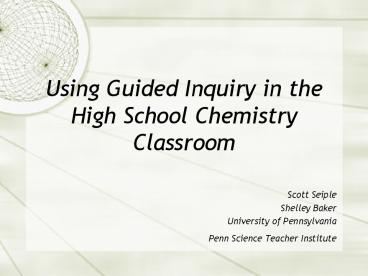Using Guided Inquiry in the High School Chemistry Classroom - PowerPoint PPT Presentation
1 / 17
Title:
Using Guided Inquiry in the High School Chemistry Classroom
Description:
Positive students attitudes are associated with: a high level of involvement. strong positive relationships with classmates. use of variety of teaching strategies ... – PowerPoint PPT presentation
Number of Views:145
Avg rating:3.0/5.0
Title: Using Guided Inquiry in the High School Chemistry Classroom
1
Using Guided Inquiry in the High School Chemistry
Classroom
- Scott Seiple
- Shelley Baker
- University of Pennsylvania
- Penn Science Teacher Institute
2
The Need for a New Approach
- Traditional lecture not optimal for most learners
- Positive students attitudes are associated with
- a high level of involvement
- strong positive relationships with classmates
- use of variety of teaching strategies
3
The Need for a New Approach
- Lectures are often highly symbolic and neglect
the particle and macroscopic nature of chemistry.
4
Why Guided Inquiry?
- Positive students attitudes.
- Opportunity to use all three levels of
representation. - Guided Inquiry supports both of these
instructional considerations.
5
What is Guided Inquiry?
- Based on POGIL model developed at Franklin and
Marshall College. - Information/data provided by the instructor can
be in many forms. - Students work in small groups to solve questions
that lead students to reach conclusions about the
data.
6
What is Guided Inquiry?
- Students must connect information to background
knowledge. - Questions being asked become sequentially more
difficult (modeling Blooms Taxonomy) - critical
thinking. - Knowledge
- Application
- Analysis/Synthesis
7
Benefits of Guided Inquiry ?
- Allows for easy and rapid formative assessment of
student understanding. - Simulates the scientific process.
8
Benefits of Guided Inquiry ?
- Addresses National Standards ? Deeper
understanding of content, not just memorization
of facts. - Builds science literacy
9
Benefits of Guided Inquiry ?
- Has high task value.
- In a well-constructed guided inquiry exercise
students will - Gain an understanding of the importance of the
concept - Comprehend the utility of the concept
- Find the topic to be interesting.
10
Use in the classroom
- Guided inquiry exercises have become part of the
instructional practice toolbox, but are not
necessarily used everyday. - Desired outcomes may not be evident at first.
- Use needs to be consistent.
11
Use in the classroom
- Requires active teacher involvement.
- Monitor groups.
- Provide additional guidance, but be careful not
to give too much away. - Ask additional questions to challenge student
understanding.
12
Use in the classroom
- Review questions and answers as a whole group.
- The frequency and method for doing this depends
upon the audience. - Maintains student focus.
- Provides needed feedback and reassurance to
students.
13
Outcomes
14
Conclusions
- This approach can get old for students and should
not be over-used. Vary the tools. - Some students may get hidden in the group.
- Some students just want to know the answers and
not value the process. - You still may not be sure of a students level of
understanding before a summative assessment.
15
Conclusions
- Requires purposeful grouping.
- Initial preparation/development is time
consuming. - Authentically forces students to assume
accountability for their own learning. - If the goal is deeper understanding be sure you
are accessing for deeper understanding.
16
Guided Inquiry
- Questions and Discussion.
17
References































